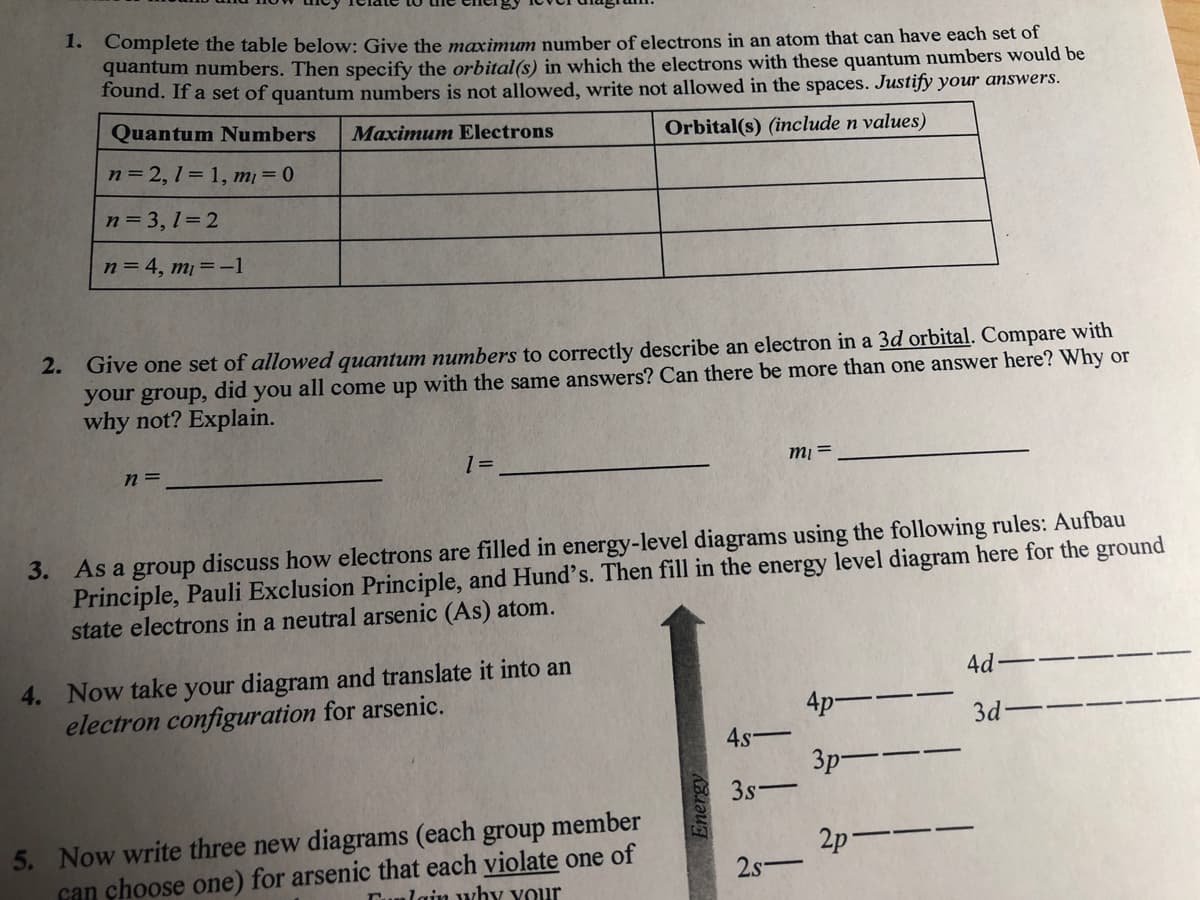1. Complete the table below: Give the maximumm number of electrons in an atom that can have each set of quantum numbers. Then specify the orbital(s) in which the electrons with these quantum numbers would be Tound. If a set of quantum numbers is not allowed, write not allowed in the spaces. Justify your answers. Quantum Numbers Maximum Electrons Orbital(s) (include n values) n= 2, 1 = 1, m = 0 n= 3, 1=2 n = 4, m =-1
1. Complete the table below: Give the maximumm number of electrons in an atom that can have each set of quantum numbers. Then specify the orbital(s) in which the electrons with these quantum numbers would be Tound. If a set of quantum numbers is not allowed, write not allowed in the spaces. Justify your answers. Quantum Numbers Maximum Electrons Orbital(s) (include n values) n= 2, 1 = 1, m = 0 n= 3, 1=2 n = 4, m =-1
Chemistry: An Atoms First Approach
2nd Edition
ISBN:9781305079243
Author:Steven S. Zumdahl, Susan A. Zumdahl
Publisher:Steven S. Zumdahl, Susan A. Zumdahl
Chapter2: Atomic Structure And Periodicity
Section: Chapter Questions
Problem 105E: One bit of evidence that the quantum mechanical model is correct lies in the magnetic properties of...
Related questions
Question
Only number 1

Transcribed Image Text:1. Complete the table below: Give the maximum number of electrons in an atom that can have each set of
quantum numbers. Then specify the orbital(s) in which the electrons with these quantum numbers would be
Tound. If a set of quantum numbers is not allowed, write not allowed in the spaces. Justify your answers.
Quantum Numbers
Maximum Electrons
Orbital(s) (include n values)
n = 2, 1 = 1, m = 0
n= 3, 1=2
n = 4, m = -1
2. Give one set of allowed quantum numbers to correctly describe an electron in a 3d orbital. Compare with
your group, did you all come up with the same answers? Can there be more than one answer here? Why or
why not? Explain.
n =
1 =
= lu
3. As a group discuss how electrons are filled in energy-level diagrams using the following rules: Aufbau
Principle, Pauli Exclusion Principle, and Hund's. Then fill in the energy level diagram here for the ground
state electrons in a neutral arsenic (As) atom.
4. Now take your diagram and translate it into an
electron configuration for arsenic.
4d
4p--
3d
4.s
3p--
3s
|
5. Now write three new diagrams (each group member
can choose one) for arsenic that each violate one of
2p-
2s-
Tunlain why your
Energy
Expert Solution
This question has been solved!
Explore an expertly crafted, step-by-step solution for a thorough understanding of key concepts.
This is a popular solution!
Trending now
This is a popular solution!
Step by step
Solved in 2 steps with 1 images

Recommended textbooks for you

Chemistry: An Atoms First Approach
Chemistry
ISBN:
9781305079243
Author:
Steven S. Zumdahl, Susan A. Zumdahl
Publisher:
Cengage Learning

Chemistry
Chemistry
ISBN:
9781305957404
Author:
Steven S. Zumdahl, Susan A. Zumdahl, Donald J. DeCoste
Publisher:
Cengage Learning


Chemistry: An Atoms First Approach
Chemistry
ISBN:
9781305079243
Author:
Steven S. Zumdahl, Susan A. Zumdahl
Publisher:
Cengage Learning

Chemistry
Chemistry
ISBN:
9781305957404
Author:
Steven S. Zumdahl, Susan A. Zumdahl, Donald J. DeCoste
Publisher:
Cengage Learning


Chemistry: Principles and Reactions
Chemistry
ISBN:
9781305079373
Author:
William L. Masterton, Cecile N. Hurley
Publisher:
Cengage Learning

Principles of Modern Chemistry
Chemistry
ISBN:
9781305079113
Author:
David W. Oxtoby, H. Pat Gillis, Laurie J. Butler
Publisher:
Cengage Learning

Chemistry & Chemical Reactivity
Chemistry
ISBN:
9781133949640
Author:
John C. Kotz, Paul M. Treichel, John Townsend, David Treichel
Publisher:
Cengage Learning